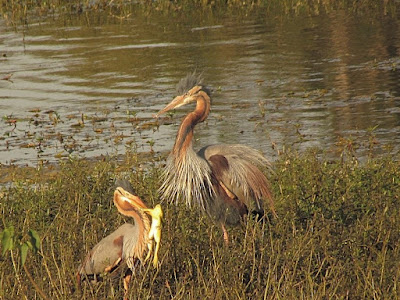Teesta Review: A Journal of Poetry, Volume 5, Number 1. May 2022. ISSN: 2581-7094
A Paradise for Birds
The newly
rejuvenated Puttenahalli Lake was ready to receive the monsoon showers of 2010.
However, with two out of six inlets functioning, the 10 acre-lake bed had only
large pools in the deeper areas while the rest of the ground greedily absorbed
the water but remained damp on the surface.
The first
drops that fell on the land made one want to take a deep breath and savour the petrichor.
Unfortunately, they also brought the wilting weeds back to life. These invasive
plants cocked a snook at the harsh summer sun that had curtailed their growth and
flourished. Before our horrified eyes, they grew and grew and swiftly covered
the water and the land.
If earlier the
lake had resembled a football ground, now it looked like a marsh. Bulrush (Typha
latifolia) grew in thickets in the shallow places but the Alligator weed (Alternanthera
philoxeroides) spread like a thick mat over the water blocking the
sunlight. A low plant with white ball like flowers, it grows equally well on
land where our gardeners keep them under control. How were we to manage them on
water? Jutting among them was another species called Polygonum glabrum
(Dense Flower Knotweed) with narrow leaves, red stem and pink flowers. We may
have been worried by the sight of these plants but the birds loved them all and
how!
We had had only
Pond Herons and egrets before but now other species began to frequent the lake.
Purple (now called “Grey-headed”) Swamphen, Eurasian Coot, Purple Heron, Little
Grebe, Common Moorhen, Prinias, Cormorants, Jacanas, Munias and more. Most of
them decided to make the lake their home and we took breaks from our chores to
watch them.
 |
| Photo: Eurasian coots chasing one another Courtesy: Ram Manoj |
The Swamphen loved
the bulrush and often sat on top of the thick tufts in a crazy balancing act.
The Little Grebe (also called Dabchick) was, well, a small bird predominantly
rufous coloured with big eyes and a bright yellow streak across the beak which
gave it a perpetual grin. The Eurasian Coot was a study in black and white.
Black all over but for a white shield which stretched like a broad band of holy
ash from the tip of the beak along the forehead. Aggressive and highly
territorial, they constantly chased each other leaving a long trail behind them
in the water much like the white smoke streak in the sky in the wake of a jet
plane.
We emailed
updates to the community so that they could come and rejoice at the sight of so
many birds in our little neighbourhood lake. The word about our Puttenahalli
Lake becoming a birds’ paradise spread and brought bird watchers from all over
the city.
Early one
morning, a group of 25 members of the Bird Watchers Field Club of Bangalore, which
had been founded in the 1970s, paid a visit to our little Lake. Almost all of
them had cameras, a few with long impressive looking lenses. Their visit
coincided with the birds’ breeding season. The lake bed was dotted with
vegetation patches. Several Eurasian Coots were swimming towards these with a
piece of reed or grass in their beaks to build nests. Others already had young
ones tagging with them – small balls of black fur with reddish faces.
Juveniles of
other species like little grebes and pheasant-tailed jacanas were in plenty too.
We stood in the viewing deck and watched the parents and their young ones. I
was basking in ‘Oohs’ and ‘Aahs’ and the lake being called “a veritable
nursery” when we heard a commotion in the reeds nearby and turned to see a
Purple Heron gobbling an adult Coot! Even as we gaped, the bird disappeared
into the wide-open beak into the serpentine throat of the heron. We were so
shocked that none of us had the presence of mind to take a photograph!
 |
| Photo: Purple Herons, one of them with the toad in its beak. Courtesy: S K Srinivas |
A few days
later another birder S K Srinivas had greater luck or perhaps better reflex. He
once heard a similar commotion, turned and clicked – much like the wicket keeper
snatching the ball as it flies off the player’s bat. What a catch he got – two
Purple Herons were fighting over a fat toad! It appeared to have been an
encounter no less than that between David and Goliath because it was the
sub-adult that held the prey in its beak and was trying to prevent the older
and bigger one from snatching it.
Srini couldn’t
tell which bird won. This question surfaces occasionally when I see a Purple Heron
at the lake. Another question that rankles is its name. As far as I can tell,
there is nothing purple about it. It is a handsome, regal looking bird no doubt
but purple? Na...
